Temples of Taichung
Like many of Taiwan’s older cities, Taichung (founded in 1705) has a large number of old temples and shrines that have historical value and are typical of the eras in which they were built. They include family and public Taoist and Buddhist temples, a Confucian temple, and even a Japanese Shinto Shrine.
Confucian temples
Confucius Temple

Unlike other cities, Taichung lacked a Confucian Temple until very recently. In order to address this deficiency, the municipal government made the decision to construct a temple. With help from the Taiwan Provencial Government as well as local private individuals, construction began in earnest in 1974 with the laying of the capstone.[1]
Today the temple is usually a pretty quiet place where people can contemplate, study, and relax. It also serves as a cultural center in the sense that people can take a handful of culture related classes (i.e. calligraphy). However, the place becomes the center of attention on the morning of September 28 every year, as Taiwanese celebrate Confucius' birthday (officially known as Teachers' Day in Taiwan) with performances at the temple.[2]
The main entrance opens into a fairly large open space with trees, a pond, and a walkway lined with hedges that leads to the Great Perfection Gate. The gate itself leads to a larger courtyard inside. Along the perimeter of the courtyard are a series of rooms that are used as offices, classrooms, a library, and a study room where students can be found studying.

In the center of that courtyard is the Great Perfection Hall. The construction employs Song Dynasty designs with patterns also deriving from the Song Dynasties. It includes a shrine to Confucius, though modestly lacks an image of the great sage.
In the rear of the main courtyard is The Sage’s Shrine, also known as the Hall of the Sagely Founder. It includes tablets that honor members of Confucius’ family.
The temple is found along Shangshi Road near the Taichung Number One High School and the National Physical Education University.
Wen Chang Temple
Family shrines
Lin Family Ancestral Temple
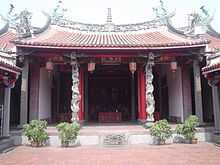
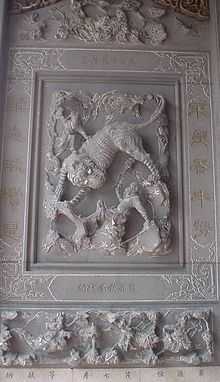
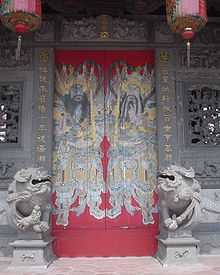
The shrine includes stone wall sculptures, wood carvings, and paintings that typify Fujianese design of the mid-Qing Dynasty era. The outer courtyard has a small brick structure used for burning paper ghost money along with traditional stone guards to protect the sanctity of the temple.
The front entrance has stone carvings on both sides and painting on the doors. The inner courtyard is also made from brick, and one can see the inner shrine from this courtyard. It also includes the traditional drum and bell and has numerous wood carvings and paintings.
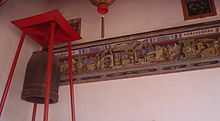
The inner shrine is a beautiful example of traditional piety of leading families of that era in Taiwan’s history.
Chang-Liao Family Shrine
Commonly known as the Chang-Liao Public Hall, it was erected by the Cheng-Liao clan that originally came from Zhangzhou, Fujian, China. It was built from 1908 to 1911 during the early years of the Japanese occupation. Wings and outlying rooms were added in subsequent years, with all work completed by 1916.
There is a hall with right and left wings, a main worship hall and various enclosed spaces. The woodwork is finely crafted and painted in traditional Qing Dynasty styles. What makes this temple special is a lion’s throne on the roof beams that are designed to ward off evil influences as well as to stabilize the main beams.
Unfortunately, the temple fell into disrepair with age. The Taichung municipal government launched a renovation project that commenced in 1988 and was completed in 1994.
Chang Family Shrine
Buddhist temples
Bao Jue Buddhist Temple

The Bao Jue Buddhist temple is unusual in that it is the only one in the city that also has a Shinto Shrine on its grounds (see below.) It is most famous for the presence of a giant smiling Buddha that can easily be seen from the street despite the presence of a wall separating the grounds from the street. The main temple itself is undergoing renovation. There are also two other buildings on the grounds that are used for various community-oriented activities.

Tzu-shan Buddhist Temple

The Tzu-shan Buddhist Temple was constructed shortly after the end of the Japanese occupation in the 1950s. It is a temple/monastery with a small number of resident Buddhist monks and nuns. The entrance to the complex has an elephant on either side.
Once inside, there is a courtyard with the main temple on the right side with lions guarding the entrance to the temple. Inside the temple is a gold Buddha statue sitting in the lotus position. There are also hundreds of smaller figurines lining the walls of the shrine.

The back area of the courtyard has a small pavilion with greenery behind it. Within that greenery is another courtyard where you may see monks and/or nuns meditating, studying, or simply relaxing. Within that courtyard, there is another opening to a green area with a statue of the Guanyin Bodhisattva. The monastery area behind the second courtyard has residences for the monks and nuns in residence.
The temple is in an out of the way area in Beitun District on a small road near Changping Road.
Taoist temples
Chenghuang Temple
Wanchun Temple
Wen Chang Temple

Wen Chang Temple is located in what is today Beitun District in northern Taichung City. The location of the temple is the heart of what was once known as An Li village, populated by the Pazea Pingpu Aboriginal tribe. Chinese exploration of this area dates back to the late years of the reign of Emperor Kangxi (1723-1735.)
By the end of the eighteenth century, Minnan (Hokkien) settlers created wenwei (learning groups) communities. After some time, in 1863, they decided to construct this temple to cultivate local learning talents.
After entering a modest gate on the modern roadside of Changping Road, one finds oneself in a courtyard looking at a broader gate. The gate has several wooden carvings on either side of the entrances that lead into another courtyard. From that second courtyard, one can see the main shrine to Wenchang Tichun.
A two-year renovation project led by a team from Tunghai University restored the temple from 1996 to 1998, but the massive 9-21 Earthquake in 1999 caused several cracks to appear in the structure. Repairs took place from 2002 to 2004.

Yuanbao Temple

The Yuanbao Temple itself is relatively small. Just outside the temple, an old tree stands beside the main gate. The gate itself has an intricate design on the top. Inside the small courtyard is a wrought iron ghost money furnace. The entrance to the temple itself has more traditional multicolored wood carvings.
Behind the temple itself is a multi-storied building that belongs to the temple and is called the Dadao Public Temple. However, there is no aesthetic architectural or artistic quality to the building.
Nantian Temple

The Nantian Temple is one of the most distinguishable temples in Taichung due the presence of a large red representation of the spirit Guangong that figures prominently above the temple and can be seen from at least a kilometer away.
While this temple is currently located on Ziyou Road near the Hanxi River and Lecheng Temple, it was originally built on Dacheng Street in North District in 1949 and it received the moniker Nantian Temple in 1950, with construction being completed in 1952. The spirit on the roof was constructed in 1984.
The interior of the temple not only includes a Taoist shrine dedicated to Guangong, but one of the side rooms also has a shrine dedicated to Confucius.
Mazu temples
Le Cheng Temple

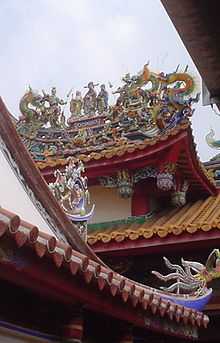
This two-storey structure is among the largest and most ornate temples in Taichung. To the left of the main temple structure is an incense burner where ghost money can be burned for the deceased, which was built in 1828. The interior of the temple includes numerous shrines to various “spirits” with intricate, complex designs. The complex roofs are constructed in a traditional Chinese style and include numerous wood carvings, including dragons, lions, as well as sculptures of people.
Opposite the main temple is also a gallery where there are small vendors today. In the courtyard in front of the temple is a pair of green stone lions, indicating the antiquity of the temple.
Le Cheng Temple has been declared a category three historical site by Taiwan’s national government. It is very busy during national holidays and as well as the first and fifteenth days of each lunar month. It is located on Hanxi Street near the Han River in eastern Taichung.
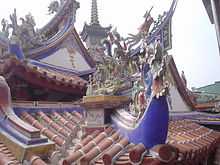
Wan He Temple
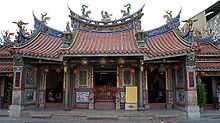
The main entrance to the temple is flanked on either side by two smaller entrances. Wood carvings of various designs adorn the traditional roof structures over the entrances to the temple. The interior has a number of shrines dedicated to Mazu that were constructed over the course of the next century and a half.
This is a very busy temple on holidays as people go to pray and dedicate themselves to Mazu and their ancestors. It is located in the heart of one of the major traditional population centers of modern Taichung.
Shinto shrine
Japanese Shrine at the Bao Jue Buddhist Temple

Within the grounds of the Bao Jue Buddhist Temple is a small, modest Japanese Shinto Shrine dedicated to the Japanese (including Taiwanese) soldiers who were fighting overseas during the war. The shrine was erected by the Japanese government.
Other traditional structures
Chishan Gate

The Chishan Gate is newer than many of the temples previously mentioned on this page, having only been built in 1924. It was built upon the recommendation of a geomancer as a gate to a residence built by Lai Chang-jung, which was built in 1897, during the early days of the Japanese occupation.
Fuzhou fir was used to build the beams and pillars while the customary intricate carvings add beauty to the structure. Behind the gate, one will find five old banyan trees, giving a feeling of relaxation despite the present urban surroundings of the grounds the gate is presently located on.
References
External links
- Ah-Taiwan: Life in Formosa - Baojue Temple information